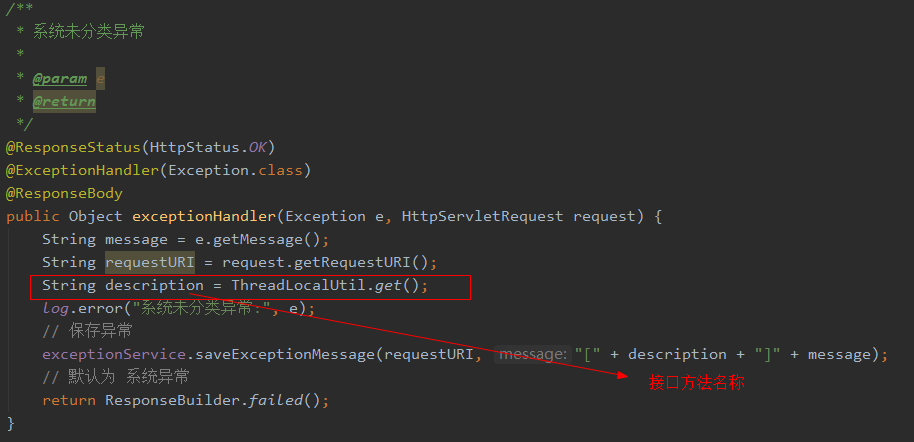1.背景
很多时候我们在梳理公共异常时,需要获取到接口的而具体名称,便于很好的提示是那个接口错误了
2.实现逻辑
1.在controller方法上的注解上写方法名称,一般使用了swagger都有方法名称;
2.使用aop通过JoinPoint,使用反射拿到注解上的方法名称;
3.把方法名称放到ThreadLocal里面;
4.在公用异常处理的地方从ThreadLocal里面获取到方法名称;
...搞定!
3.具体代码
1.在controller方法上的注解上写方法名称,一般使用了swagger都有方法名称;

2.使用aop通过JoinPoint,使用反射拿到注解上的方法名称;
/** * @Description 获取注解中对方法的描述信息 用于Controller层注解 */ public static String getControllerMethodDescription(JoinPoint joinPoint) throws ClassNotFoundException { String description = ""; String targetName = joinPoint.getTarget().getClass().getName(); String methodName = joinPoint.getSignature().getName();//目标方法名 Object[] arguments = joinPoint.getArgs(); Class targetClass = Class.forName(targetName); // 获取类上的注解 Annotation annotation1 = targetClass.getAnnotation(Api.class); if (annotation1 != null) { String[] tags = ((Api) annotation1).tags(); for (String tag : tags) { description += tag; } } // 获取方法上的注解 Method[] methods = targetClass.getMethods(); for (Method method : methods) { if (method.getName().equals(methodName)) { Class[] clazzs = method.getParameterTypes(); if (clazzs.length == arguments.length) { ApiOperation annotation = method.getAnnotation(ApiOperation.class); description += annotation == null ? "未命名接口" : annotation.value(); break; } } } return description; }
3.把方法名称放到ThreadLocal里面;
调用set方法即可
public class ThreadLocalUtil { private static ThreadLocal<String> localVar = new ThreadLocal<>(); public static void set(String name) { localVar.set(name); } public static String get() { String s = localVar.get(); localVar.remove(); return s; } public static void remove() { localVar.remove(); } }
4.在公用异常处理的地方从ThreadLocal里面获取到方法名称;

完美!